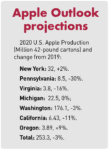

Oct 7, 2020Apple forecast down slightly despite challenges
Despite obstacles brought about by a global pandemic, continuing labor challenges and damaging weather events, the U.S. Apple Association estimates the 2020 crop at 253.31 million 42-pound cartons.
The association’s forecast essentially equaled the USDA’s August estimate of 253.57 million cartons, 3% less than the 2019 crop and 2% below the five-year average. “The apple industry faced many challenges this past year, but rose to meet every one of them,” said U.S. Apple President and CEO Jim Bair. “Growers and apple businesses weathered the confluence of a perfect storm this past year and came out the other side, which is a testament to our members.”
Mark Seetin, director of regulatory and industry affairs for USApple, remained optimistic about the 2020 outlook despite numerous challenges.
“Marketing the 2020 crop will be a challenge, but the industry has demonstrated the ability to handle larger crops,” Seetin said during the U.S. Apple Outlook Conference, held virtually for the first time Aug. 20-21. “The projected size of the 2020 crop puts it well within the size range that they have successfully marketed.” Seetin said, “marketing the 2020 crop represents some unique challenges:
• “The export market is still affected by trade tensions and COVID-19.
• “Additional domestic challenges continue until a reliable vaccine allows a return to normalcy.
• “Opportunities exist, as well, including expanding production of new varieties aimed at consumer preferences, and pursuit of innovative marketing programs.”
In the East, growers reported spring frosts that impacted New York’s Hudson Valley and parts of Pennsylvania and Virginia that reduced the bloom on many varieties.


The 2020 New York crop estimate of 32 million cartons is 3.3% higher than the USDA average, 2% higher than the 2019 crop and 1% above the five-year average. Growers said the New York production was tracking normal to a few days early, and indicated the final crop volume will be determined by sizing. The Pennsylvania crop estimate came in at 8.5 million cartons, down 15% from the USDA August estimate, 30% below the 2019 crop and 29% lower than the five-year average. Timing on early varieties were seven to 10 days later than 2019.
The Virginia crop estimate from USApple is 3.8 million cartons, level with USDA’s August estimate, down 16% from a year ago and off 20% from the five-year average. Virginia harvest timing was lagging about seven days later than normal.
In Michigan, USApple’s estimate of 22.5 million cartons was 2.7% above the USDA’s August estimate, unchanged from a year ago and 8% below the five-year average. Quality of Michigan apples was expected strong, growers indicated.
“Growers used many tools to prevent damage from frost in early May,” Diane Smith, executive director of the Michigan Apple Committee, said in a news release.
“While some areas of the state were impacted more significantly than others, overall we are hearing reports of a quality crop with minimal frost damage. Growers report that Honeycrisp, in particular, are looking exceptionally good this year, which means we’ll have great opportunities for retail programs for that consumer favorite variety.”
West down a bit
In the West, USApple participants predicted the California crop estimate at 6.43 million cartons, unchanged from the USDA estimate, down 11% from last year and off 9% from the five-average.
Growers felt USDA’s Oregon 4.29 million cartons forecast was too high. USApple predicted 3.89 million cartons, down 9% from the August USDA crop estimate but up 9% from 2019 and unchanged from the five-year average.
In Washington, growers in discussions at the Outlook event were split on the amount of fruit on the tree, but the USDA’s August forecast was in the middle of this range and so was left unchanged at 176.19 million cartons, down 3% from last year and up 6% from the five-year average.


Since the time of the initial estimate, extreme windstorms, wildfires on the West Coast and more accurate reporting of crop load on the trees as harvest progressed, suggested a lighter total crop volume for the 2020-21 apple harvest.
Over Labor Day weekend, a strong windstorm resulted in apples being knocked off the tree and some growers sustaining damage to their trellis systems. Fueled by the wind event, wildfires burning in Washington and other West Coast states have produced intense smoky conditions, delaying harvest a few days as some areas have had to halt operations.
According to a Sept. 16 news release from the Washington Apple Commission, expectations were for a 5-10% reduction in crop volume as a result of the adverse weather events.
Washington apple growers and orchard crews started picking Galas in late August and have since moved on to Honeycrisp. Harvest in Washington typically begins mid-August and lasts into November. Red Delicious, Fuji and Cosmic Crisp will be harvested in October and the season will wrap up with Granny Smith and Cripps Pink in November.
Demand for Washington apples has been high in response to elevated health-conscious and bulk-purchase behavior by consumers. Volume of apples shipped during this time perio is slightly lower than last season, but overall movement is good. Suppliers are working hard to meet the demand and keep on pace with season goals.
Washington is the leading producer of apples, representing 65% of all U.S. fresh apple production. The state exports one-third of its fresh crop to over 60 markets worldwide, accounting for 95% of all U.S. apple exports.
— Gary Pullano, managing editor














